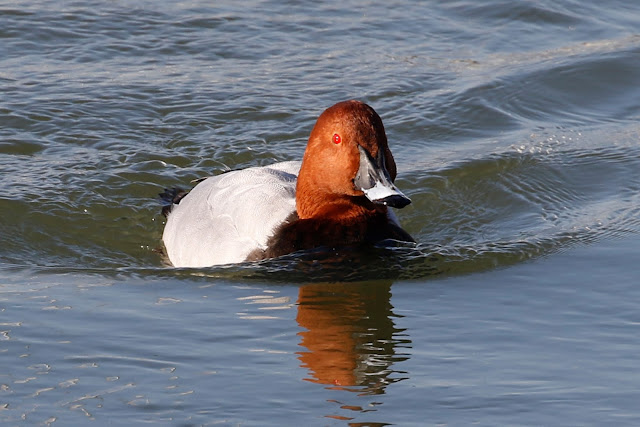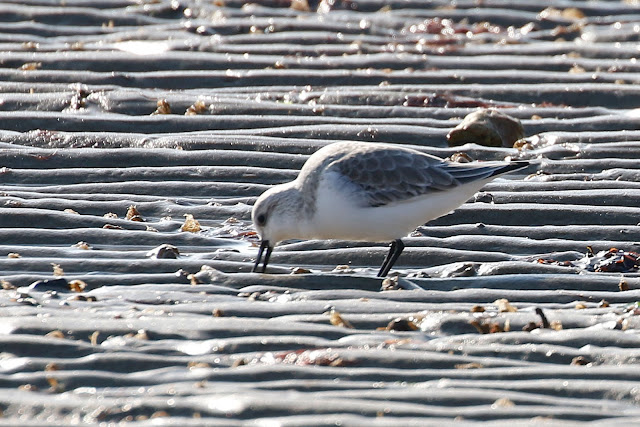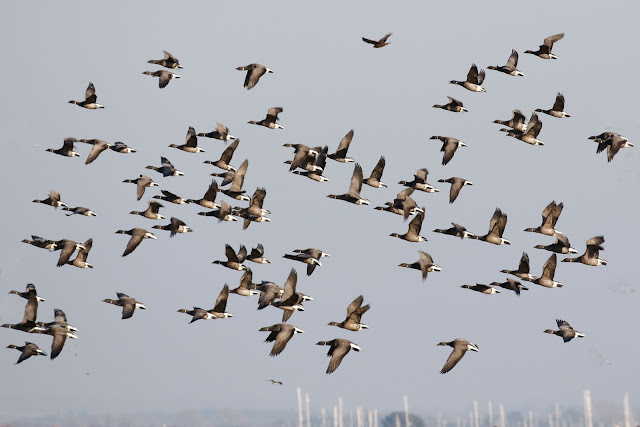This weekend too, as I was on my own, there was no incentive to get up too early, however I arrived at the sea wall with still 30 minutes until the reserve opened so I wandered around the beach behind the sailing club, the tide was falling and in the shallow water there were Redshank and Oystercatchers, while Brent geese were a little further out, and several would fly past.
I walked around to the visitor centre, and stopped on the bridge to check for anything below. A pair of Gadwall were close to the reeds, and in the sunshine the drake looked immaculate.
With Teal, Pintail, Wigeon, and even Mallard about the Gadwall is almost overlooked, but on close inspection it is really beautiful, with the grey waves around the breast and flanks.
The water was falling in the harbour, and Turnstone could be seen on the edge of the mud. The swans and Mallard were gathering in anticipation of being fed as the centre opened, and in amongst them was the drake Pochard. At first swimming over to join the groups
Then being a little more cautious as the numbers of other ducks increased.
I had a result in the visitor centre, as my newly acquired age qualified me for a reduced fee, and then I headed off down the east side towards the Meadow Hide. Along the Boardwalk Great Tits and Robins were singing in the sunshine. In the hide I was on my own, and I settled down for what I proposed to be a good time, I was going to give the bittern time to show.
Almost immediately all the duck went up on the Frying Pan, and from behind the trees came a male Marsh Harrier, drifting over the water and meadow with that twisting and bobbing flight, with wings held in the distinctive "V".
The Harrier headed past the hide and flushed more ducks, and then dropped out of sight within the reed bed.
A few minutes later a female came from the same direction, again upsetting the ducks and gulls.
It took the same route as the male, but returned a little later and went from view behind the distant trees. I sat scanning the distant reeds, and examining harder the closer ones. A Grey Heron raised hoped as it came out of the reed bed, and flew across the meadow.
Then the female Marsh Harrier appeared again, this time coming closer to the hide.
Following the trees at the back of the Frying Pan.
A brown bird walking through the meadow once again had the pulses racing, but turned out to be a Curlew.
Then in one of my scans of the distant reed bed I saw the Bittern. The view last for a few seconds as it appeared from behind the trees, and almost immediately dropped into the reeds, the sun catching the rich brown plumage, and making the identification easy. I waited and waited, the Marsh Harrier returned, the female once again. First low over the water as if enjoying just teasing the duck and gulls
Then up and over the trees at the back.
I had given the Bittern two and half hours, and was rewarded with probably less than five seconds of a view.
It was time to move on, so I headed back to towards the centre. Long-tailed Tits had replaced the Great Tits along the boardwalk.
In the harbour were the expected Turnstone, but with them was a single Ringed Plover.
Although it looked like there was very little on the west side I walked to the Meon Shore Hide. As I opened the door and raised the window I was greeted with silence and emptiness, not something I am sure there will be in abundance in a few weeks time as the Black-headed Gulls take up residence.
I didn't stay long there was little point so I made my way back to the car. But before setting off I scanned the exposed mud, to the west there were plenty of people and dogs on the beach, so I saw little chance of any waders there. To the east at the Sailing Club, there were plenty of birds along the water's edge, and I could see the bird I hoped to find, the Sanderling.
The sun was a problem and I walked around to try to get it behind me and able to pull some of the silvery grey plumage out.
The Sanderling were feeding with sewing machine precision, pushing their bills rapidly into the mud.
Small groups moved past me, stitching the mud ferociously.
Sanderling are easily my favourite wader, they are approachable, but at the same time have Duracell like energy driving clockwork feet, I just adore watching them scurrying across the mud, and evading the waves as they push the birds back up the beach. In winter the plumage is a beautiful silvery grey, and as the spring comes there are signs of the brick red and browns of the breeding plumage.
Finally I got just a little too close and they flew off.
I counted 36 birds, with a few following up past me.
With the Sanderling now far away along the mud I headed back to the ca and also set off towards the east where the next stop was Hayling Island, and the Oyster Beds.
As I arrived the car park was almost full and there were plenty of people about walking the paths. The tide was now just past low, and mud stretched out before me. From the behind the bank though I could hear the contact calls of Black-tailed Godwits, and creeping up to the bank I was able to catch a small group feeding.
At the Oyster Beds there was a small group of Black-headed Gulls in various stages of plumage, some showed an almost full chocolate brown hood, while other younger birds were still quite plain.
I had hoped the Mediterranean Gulls might be about, but there was no sign of them. All I could find was this adult Common Gull.
Scanning the harbour I counted ten Black-necked Grebes, but an awful long way out. With them too were eight Great-crested Grebes. There was little else to hold my attention so I decided to make my way back to the car for some lunch, and then to move on. In the flooded field alongside the main Billy path was a lone Greenshank, but it was a little flighty, and preferred to use the gullies to hide in before finally flying off.
As you can see the bird is colour ringed, but as yet I have no information on it.
From Hayling it was a short drive to Farlington. The tide was still high so I decided to walk the circle by heading first to the information hut, and rather than the cycle path I walked through the bushes. At one point a falcon flying low over the ground was exciting, hoping for a Merlin, but as it flushed the finches I could see it was a Kestrel.
I caught up with the Kestrel once again when it was sitting in a tree by the information hut.
On the stream were a few Black-tailed Godwits,and teal. Coming out into the fields it all became about the geese, the majority being Brent Geese. They were spread out across the fields and with them were also plenty of Canada Geese and Shelduck. Not immediately visible, but showed when spooked were the Lapwing, and good numbers of Starling. The Starling would bunch when the Lapwing went up, but I couldn't find any raptor that may have caused it. The larger bird in this view is a Lapwing.
The tide was slowly rising but there was plenty of mud visible, along the tide line Dunlin and Grey Plover were feeding and moving.
A rising tide is the perfect time to catch the ducks and geese in flight as they mover from the harbour to the fields. Here Shelduck.
The main reason for being here was the hope that maybe a Short-eared Owl may show, however Point Field, the area where they were seen so often last winter, was flooded and the their roosting area was under water.
A pair of Stonechat showed in the bramble alongside a ditch, this male posing in the sunshine.
On one of the pools close to the sea wall was a drake Shoveler. So intent on dabbling and feeding the Shoveler did not seem to concerned by me and I was able to creep closer as it up ended. In the sunshine the head showed bottle green, but others on the eastern side earlier were showing a deep blue head.
As I watched the Shoveler a single Dunlin flew into the pond and settled down in front of a small island.
But it was the Shoveler that kept my attention.
The intention was to reach the viewing point as the tide began to rise much more quickly.
On the lake the duck were using the reeds as shelter from what was now a strengthening cold easterly wind.
Out on the mud there were good numbers of Pintail, and every so often they would fly over the sea wall into the lake. A single drake.
Followed by a pair of drakes.
Drake and duck
Then a larger group with female.
Two pairs
And finally a single drake again that you could almost reach out and touch, the light now becoming perfect
Across the reed bed a Marsh Harrier was quartering, and as it turned from the reeds to head out over the fields the Brent Geese all took up. The harrier being at the top of the picture.
Just why the geese see the harrier as a threat is interesting, it must just be the conditioning to be wary of the raptor shape.
All the time there had been a group of Avocet on the lake, and another group out in the harbour. At first those on the lake flew out into the harbour, and I missed them. The group in total consisted of thirty birds, and it was a case of waiting and hoping that they would return to the lake, fling over the wall.
It didn't take too long a wait, and in small groups the Avocet started to return. In flight the black and white plumage stands out like a beacon against a light sky
But also contrasts nicely with the blue of the late afternoon sky.
Slowly all the birds in the harbour returned to the lake.
Dropping down on to the water with a flickering of black and white wings.
The cold wind was winning and standing still was only increasing the cold, so I decided it was enough and made my way to the car.
Highlight of the day was the very brief, but definite view of the bittern, but ably supported by the clockwork Sanderling, and the ducks and Avocet at Farlington.


















































No comments:
Post a Comment